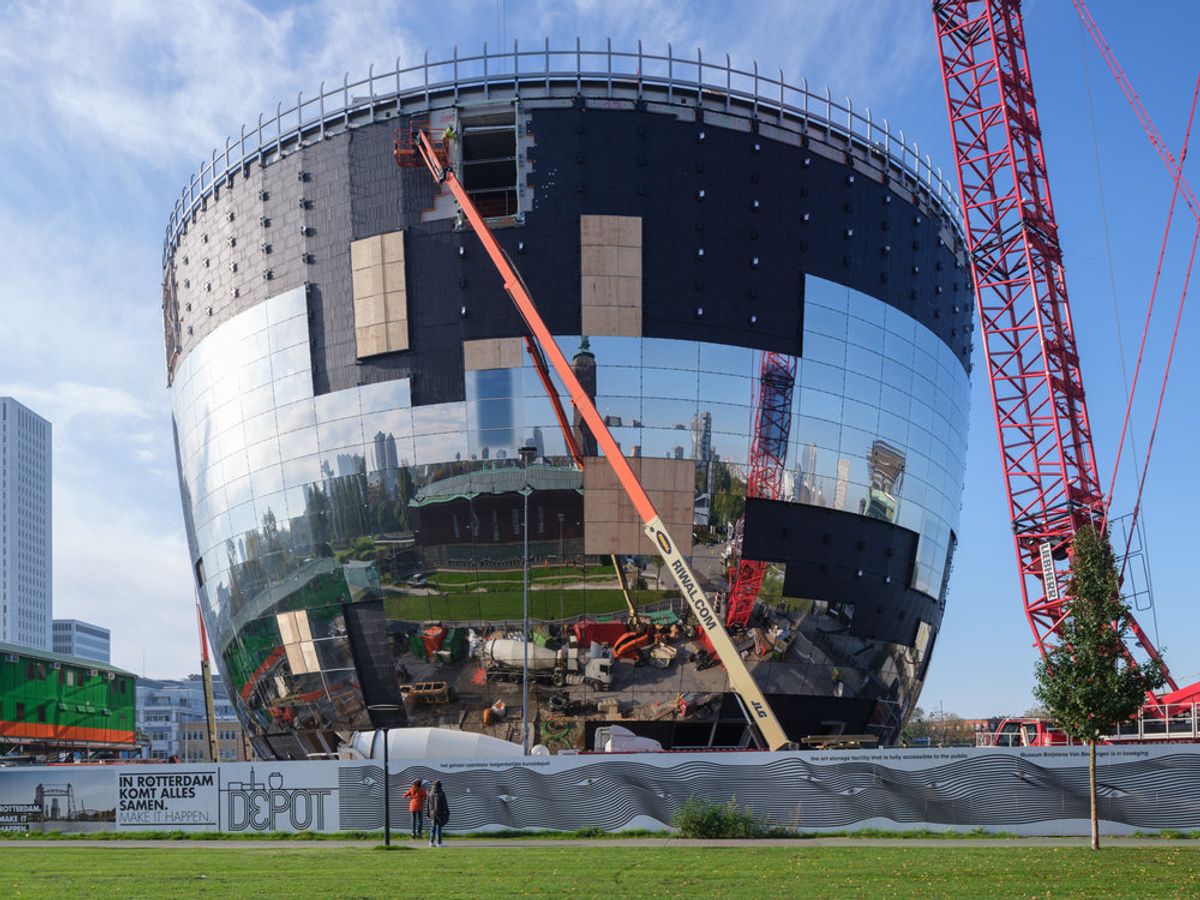At the Museum Boijmans Van Beuningen in Rotterdam, old meets new in the gleaming mirrored tiles of the vast storage depot currently under construction. The tower of the 1930s museum is reflected in the exterior of the new building amidst the thick, grey clouds of a Dutch winter’s day.
The Boijmans has been ahead of the curve in the trend to build huge new museum storage facilities that will also be accessible to the public. In October, the Centre Pompidou announced a 22,000 sq. m “art factory” opening in 2025 in Massy, a 30-minute train ride from Paris. And the city of Moscow unveiled an ambitious project to store the collections of 27 national and municipal museums in a 70,000 sq. m facility in the suburbs. London's Victoria and Albert Museum is pressing ahead with its plans, announced in 2018, to move around 250,000 objects and 917 archives east to a site in the Olympic Park where visitors may view exhibits that have been locked away for decades.
The €85m Depot Boijmans Van Beuningen is the brainchild of the museum’s director, Sjarel Ex, who gave The Art Newspaper an advance tour of the facility in late November. Scheduled to open in 2021, the depot is anticipated to welcome around 90,000 visitors a year (just over a third of the museum’s annual visitor numbers).
The 15,000 sq. m building—designed by Rotterdam-based architects MVRDV—will open its doors in 2020 as an empty shell, allowing the public to see the transformation as works of art are moved in from their current storage sites across the city. By the end of 2021, the depot will hold 151,000 pieces, of which 88,000 drawings and prints. These include works by Rembrandt, Van Gogh and Monet, a 15th-century Madonna and Child attributed to Fra Angelico, Salvador Dalí’s Mae West Lips Sofa and contemporary pieces by Andy Warhol and Olafur Eliasson.
There is a palpable sense of excitement on the construction site as Ex describes the possibilities of the new building, leading the way across cables and past drying concrete. “In the museum world, many people think the depots are hidden places for curators only, and the public shouldn’t go there,” he says. “But we realised that 50% of everything we do happens here, behind the scenes, and we thought it would be very interesting to invite the public in to see all that.”
Works of art will be suspended in huge vitrines hanging down through the central atrium; some are already in place, still in their protective wrappers. Visitors will be able to witness the whole gamut of a museum’s behind-the-scenes workings, Ex promises. In addition to the stored exhibits, there will be conservation in action, works being packaged and dispatched to other museums on loan (the Boijmans lends around 600 objects a year). Even the offices are on view.
It is the very definition of transparency, although areas on the upper floors that have been earmarked to store private collections will only be open to the public if and when their owners decide. This mixing of public and private collections is another innovation. Ex says it came about after he realised that some private collectors lacked suitable space to house their art. There are even plans, recently agreed with customs officials, to run a freeport inside the depot: all goods there will be listed for the authorities, and accessible to them.
What brought the Boijmans to this radically open-access approach to the museum’s art? The concept goes back to a potentially devastating flood in 2015, when Ex was alarmed to hear, after 13 hours of relentless rain, that he had to choose between the library and the collection, because firefighters could not save both. In what he regards as a miracle, they did in fact save the art, but it brought home the folly of storing priceless works underneath the museum. “I said, this is never going to happen again,” Ex recalls. “That was the absolute deciding factor that we had to go ahead with this new way of doing storage.”
Where the collection was kept once below ground, it will now be above: the new depot rises to 39 metres and will have a tree-encircled restaurant on its rooftop. Encased in 1,664 mirrored plates, the structure resembles a teacup without the handle—or a disco ball. The mirrors are intended to reflect Rotterdam’s buildings, according to Ex.
It is perhaps a goldfish bowl image that best captures the public-facing depot, an ethos that is being carried forward in the current arrangements for the collection while the museum is closed for renovation. During the seven-year, €223.5m modernisation, curators are sharing selected works with Rotterdam schoolchildren through the “Boijmans in the Classroom” initiative, while “Boijmans Next Door” aims to lend hundreds of pieces to other museums in Rotterdam as well as internationally.


